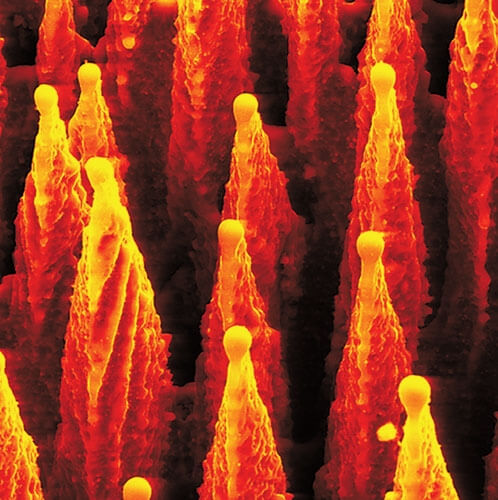News
Researchers in the Mazur group have been using femtosecond laser pulses to modify the surface and chemical composition of silicon. The rough surface, shown in this false-color SEM, changes the optical and electronic properties of the "black silicon."
Cambridge, Mass. - January 19, 2012 - Five researchers at the Harvard School of Engineering and Applied Sciences (SEAS) will be honored next week for their "pioneering contributions" to energy-efficient photonics.
They will be presented the Green Photonics Award for Laser-assisted Manufacturing and Micro/Nano Fabrication by SPIE, the international society for optics and photonics, at the SPIE Photonics West conference in San Francisco.
The Green Photonics Award is given to the top research paper in each off our categories: Laser-assisted Manufacturing and Micro/Nano Fabrication; Solid-state Lighting and Displays; Communications; and Renewable Energy Generation—Fusion and Photovoltaics.
The award in the laser category recognizes "outstanding contributions to green photonic technologies that enable precision fabrication with low waste."
The winning paper was written by Eric Mazur, the Balanski Professor of Physics and Applied Physics, with graduate students Benjamin Franta (lead author), Meng-Ju Sher, and Katherine C. Phillips in the Harvard Department of Physics, and Yu-Ting Lin at SEAS.
Their work involves using femtosecond laser pulses to modify and control both the chemical composition and the surface structure of silicon. These modifications affect the optical and electronic properties of the material—so-called "black silicon"—advancing its potential for use in novel photovoltaic devices and improving the efficiency of solar cells.
Mazur is a fellow and life member of the American Physical Society, a fellow of the Optical Society of America, a member of SPIE, and chairman for the scientific advisory board of SiOnyx, a company he founded in 2005. He has also won numerous teaching awards for his development of innovative pedagogy.
Conference chair Steve Eglash, an energy and environment expert at Stanford University, commented on the significance of the Green Photonics Awards:
"Photonics pervades all areas of modern life," Eglash said. "These awards recognize innovative research with the potential to advance new solar power systems, solid-state lighting for homes and businesses, faster and more capable computer networks, and many other technologies. These are vitally important elements in the strategy to move toward more energy efficiency and improved living conditions around the world. Photonics, with its interdisciplinary nature, has enormous capability to drive such improvements."
"The winners of the Green Photonics Awards and others presenting in this virtual conference at Photonics West are leading the way toward a better future," he said.
The award will be presented on January 25.
###
SPIE, the international society for optics and photonics, was founded in 1955 to advance light-based technologies. Serving more than 180,000 constituents from 168 countries, the Society advances emerging technologies through interdisciplinary information exchange, continuing education, publications, patent precedent, and career and professional growth. SPIE annually organizes and sponsors approximately 25 major technical forums, exhibitions, and education programs in North America, Europe, Asia, and the South Pacific. SPIE provided over $2.5 million in support of education and outreach programs in 2011.
An earlier press release issued by SPIE is available here.
Topics: Environment, Applied Physics
Cutting-edge science delivered direct to your inbox.
Join the Harvard SEAS mailing list.
Scientist Profiles
Eric Mazur
Balkanski Professor of Physics and Applied Physics



